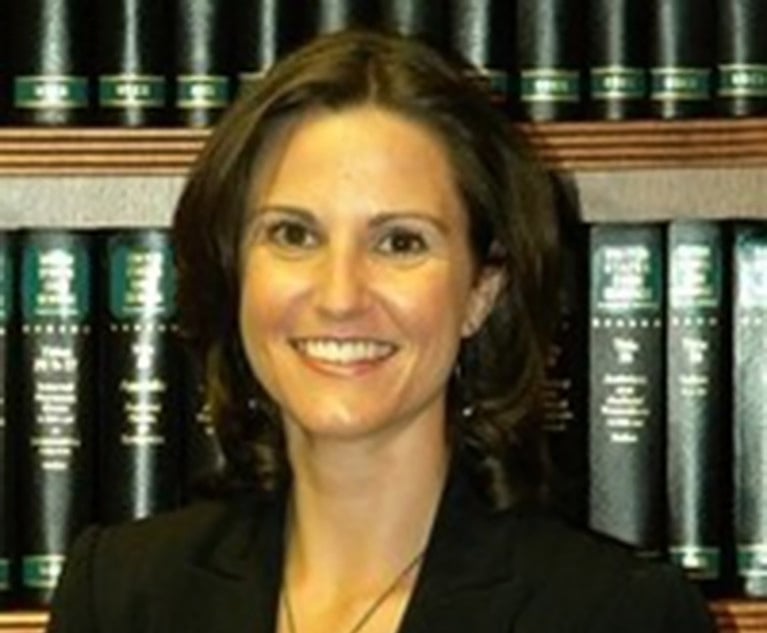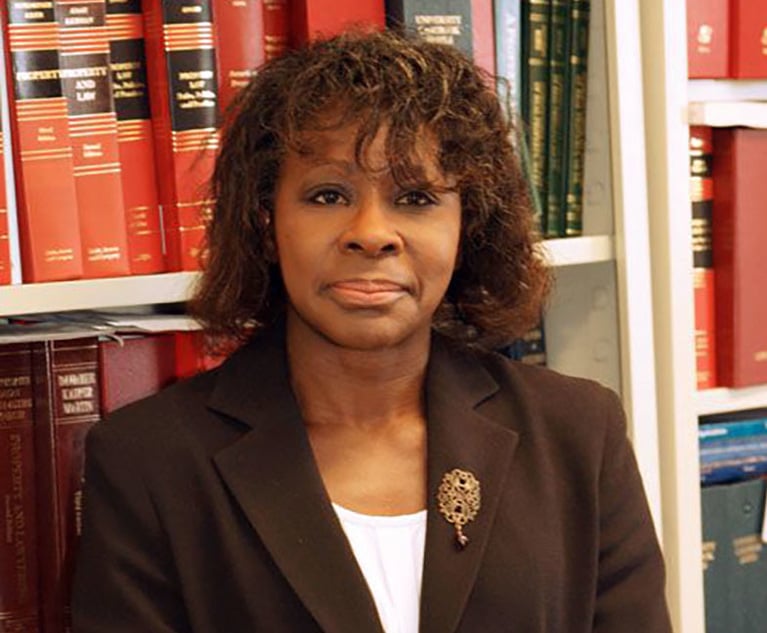Managing Toward Career Satisfaction, Professional Development and Client Service
Things have changed over the years, certainly in terms of the economics of the profession, but in many ways, we have lost many of the aspects of law practice that made for more satisfying careers, professional development and client service. I view a central goal of law firm management as managing to preserve many of those values for my colleagues as well as my clients.
May 10, 2019 at 01:40 PM
8 minute read
 Much is written about law firm management, but there is little consideration of the objectives toward which you are trying to manage. That is not as straightforward a question as it may seem.
Much is written about law firm management, but there is little consideration of the objectives toward which you are trying to manage. That is not as straightforward a question as it may seem.
As senior partner of an international disputes boutique, I have represented large law firms and worked with lawyers at firms large and small all over the world. Private law firms are, of course, businesses and an important purpose of any business is to generate profit. But if you are practicing law just to make money, you are in the wrong business. Become an investment banker or run a hedge fund. When I graduated from law school, law was still a profession more than a business. Lawyers earned good incomes but did not earn like rock stars or professional athletes. Things have changed over the years, certainly in terms of the economics of the profession, but in many ways, we have lost many of the aspects of law practice that made for more satisfying careers, professional development and client service. I view a central goal of law firm management as managing to preserve many of those values for my colleagues as well as my clients.
When I began practicing law, big law firms in major cities might have had 150 or so lawyers. Medium size law firms were around 50 or 60 and there were plenty of top quality-law firms that had 15 or 20 lawyers. Law firms in smaller cities were generally smaller. Most law firms had one office, or possibly a home city office and an office in Washington, D.C. A few had small offices in London or Paris, where the senior partners loved to have a week or two during good weather months. If matters were based out of town or overseas, law firms would engage firms in those places, sometimes developing “best friends” relationships.
Most lawyers knew everyone or virtually everyone in the firm. Lateral moves were rare, and the expectation was that a lawyer would spend his or her (mainly his, to be sure) career with the people with whom he began his career, perhaps with a stint in public service. Teams on a case consisted of two or three lawyers. Leverage was relatively limited. There were exceptions to this model, but it was the general template for the profession.
Then everything changed. To be successful, law firms required critical mass, so minimum head counts went to 500 and then 1,000 and now the 10 largest law firms in the world range in size from approximately 2,000 to 4,700 lawyers. Law firms need to have offices in a number of major cities. DLA Piper is in more than 90 cities. Law firms try to offer “seamless service” across the globe.
The legal press breathlessly reports multiple lateral moves every week and which firm has now broken the $1 billion revenue mark. The inequality coefficient between top earning partners and lowest earning partners has ballooned. Free agency is more active in BigLaw than baseball. Paul, Weiss, Rifkind, Wharton & Garrison reported average profits per partner of $5 million and recently recruited a partner for $10 million per year. Kirkland & Ellis poached a partner from Cravath, Swaine & Moore for a reported $11 million per year, while William Barr, who spent time at Kirkland between stints as U.S. Attorney General, reported $1.2 million in annual income plus a $50,000 bonus. What George Orwell wrote in Animal Farm applies to law firms: “All animals are equal, but some are more equal than others.”
Where once clients had continuity with law firms from generation to generation, the name of the game today is business generation and individual partners are compensated accordingly. When a law firm has a bad year or two, the top earners often head for the exits and a number of large firms have gone into the death vortex, collapsing in a few months.
Leverage of four to five associates per partner is common. Where once partners had to be home grown, now it is more likely for many big firms to make a partner laterally than vertically. Associates are told they can work from home and need not come into the office, which makes it more likely that the model for legal practice is less collaborative and more inbox to outbox. Associate salaries are high, but stints in law firms are shorter. There are still training seminars, but a partner sitting one on one with an associate to teach him or her to write a brief or structure an agreement is far less common. Lawyers at every level report longer hours, more stress, and less in-court experience, autonomy and job satisfaction.
Perhaps this is the way of things and it is anachronistic or quixotic to look toward a different model for running a law firm. Nostalgia is not a business plan. Many fine small law firms have gone out of business or merged into larger law firms. Others have lost their most capable people and our firm has certainly lost people over the years who could not turn down more lucrative opportunities or who wanted more protection against the economic ebb and flow of a small litigation practice. I still maintain, however, that it can be done for the benefit of lawyers, senior and junior, for staff, and, indeed, for the benefit of clients as well.
Managing a small law firm certainly poses particular challenges. One does not have the same economies of scale. Absence of leverage makes it harder to generate profits. Clients hire the firm for its expertise at senior levels, to provide solutions based more on experience and judgment rather than name recognition. The brand is harder to build at least in large domestic markets, especially New York, so we focus on foreign markets with large problems in New York—often with respect to complex financial disputes. We represent hedge funds and individual entrepreneurs and foreign financial institutions and insurers as well as foreign sovereigns and large family conglomerates or trusts. Fortune 500 companies are more reluctant to take a chance with a firm our size, as the general counsel may be on the hook for not hiring a mega-firm if a case goes badly. But there are fortunately quite a few law firms and entities in the Middle East and Latin America and Liquidators or barristers in London that we have worked with over many years and where we are as well-known as the AmLaw 100.
Of course, the key issue for building and preserving a law firm culture is finding people with shared values who understand and buy into our model. They know that there are tradeoffs. We can't promise 15% year on year profit growth. We have had great, BigLaw-like years and we have had off years. We have some contingent and partial contingent work. That helps us compete for significant cases where other firms may have less flexibility in setting fees. We are happy to work with law firm funders who provide a sober early review of potential cases. Thankfully, they have worked out well, but there is always the chance that there will be a large investment and limited return.
We have had periods during which we have invested huge amounts of time for many years on Guantanamo and death penalty work. We litigated on behalf of hunger strikers at Guantanamo, as well as for journalists who were targeted by drone strikes. We have handled civil rights class actions pro bono. We used our trial and Middle Eastern experience to work with the Federal Public Defender on the case of Abu Khatallah, the Libyan who was grabbed in Benghazi and charged with the murder of our Ambassador and three others. All of this work affects the bottom line. In some years, by a lot. But the satisfaction of getting someone off death row or hugging a client who has been returned to his home country after seeing him for years in shackles in Guantanamo is not something you can quantify.
So, one needs to find lawyers with a real commitment to the values of the institution. That means sharing the work, looking at the work as not only my work but the work of the law firm, and being committed to what we do and how we do it. I have practiced with a number of my partners since I left law school. Some of them were at law school with me. Few people leave or retire, and it is good for both the senior lawyers and the junior lawyers to have lawyers in their 20s interacting with lawyers in their 80s. If people are committed to what they are doing, to doing it at a very high level, are candid with themselves and each other about their contributions, and enjoy their colleagues, the money takes care of itself.
Eric L. Lewis is senior partner at Lewis Baach Kaufmann Middlemiss, PLLC and practices in the areas of international litigation and arbitration, serious fraud, banking, international insolvency and complex securities litigation.
This content has been archived. It is available through our partners, LexisNexis® and Bloomberg Law.
To view this content, please continue to their sites.
Not a Lexis Subscriber?
Subscribe Now
Not a Bloomberg Law Subscriber?
Subscribe Now
NOT FOR REPRINT
© 2025 ALM Global, LLC, All Rights Reserved. Request academic re-use from www.copyright.com. All other uses, submit a request to [email protected]. For more information visit Asset & Logo Licensing.
You Might Like
View All


Trending Stories
- 1Uber Files RICO Suit Against Plaintiff-Side Firms Alleging Fraudulent Injury Claims
- 2The Law Firm Disrupted: Scrutinizing the Elephant More Than the Mouse
- 3Inherent Diminished Value Damages Unavailable to 3rd-Party Claimants, Court Says
- 4Pa. Defense Firm Sued by Client Over Ex-Eagles Player's $43.5M Med Mal Win
- 5Losses Mount at Morris Manning, but Departing Ex-Chair Stays Bullish About His Old Firm's Future
Who Got The Work
J. Brugh Lower of Gibbons has entered an appearance for industrial equipment supplier Devco Corporation in a pending trademark infringement lawsuit. The suit, accusing the defendant of selling knock-off Graco products, was filed Dec. 18 in New Jersey District Court by Rivkin Radler on behalf of Graco Inc. and Graco Minnesota. The case, assigned to U.S. District Judge Zahid N. Quraishi, is 3:24-cv-11294, Graco Inc. et al v. Devco Corporation.
Who Got The Work
Rebecca Maller-Stein and Kent A. Yalowitz of Arnold & Porter Kaye Scholer have entered their appearances for Hanaco Venture Capital and its executives, Lior Prosor and David Frankel, in a pending securities lawsuit. The action, filed on Dec. 24 in New York Southern District Court by Zell, Aron & Co. on behalf of Goldeneye Advisors, accuses the defendants of negligently and fraudulently managing the plaintiff's $1 million investment. The case, assigned to U.S. District Judge Vernon S. Broderick, is 1:24-cv-09918, Goldeneye Advisors, LLC v. Hanaco Venture Capital, Ltd. et al.
Who Got The Work
Attorneys from A&O Shearman has stepped in as defense counsel for Toronto-Dominion Bank and other defendants in a pending securities class action. The suit, filed Dec. 11 in New York Southern District Court by Bleichmar Fonti & Auld, accuses the defendants of concealing the bank's 'pervasive' deficiencies in regards to its compliance with the Bank Secrecy Act and the quality of its anti-money laundering controls. The case, assigned to U.S. District Judge Arun Subramanian, is 1:24-cv-09445, Gonzalez v. The Toronto-Dominion Bank et al.
Who Got The Work
Crown Castle International, a Pennsylvania company providing shared communications infrastructure, has turned to Luke D. Wolf of Gordon Rees Scully Mansukhani to fend off a pending breach-of-contract lawsuit. The court action, filed Nov. 25 in Michigan Eastern District Court by Hooper Hathaway PC on behalf of The Town Residences LLC, accuses Crown Castle of failing to transfer approximately $30,000 in utility payments from T-Mobile in breach of a roof-top lease and assignment agreement. The case, assigned to U.S. District Judge Susan K. Declercq, is 2:24-cv-13131, The Town Residences LLC v. T-Mobile US, Inc. et al.
Who Got The Work
Wilfred P. Coronato and Daniel M. Schwartz of McCarter & English have stepped in as defense counsel to Electrolux Home Products Inc. in a pending product liability lawsuit. The court action, filed Nov. 26 in New York Eastern District Court by Poulos Lopiccolo PC and Nagel Rice LLP on behalf of David Stern, alleges that the defendant's refrigerators’ drawers and shelving repeatedly break and fall apart within months after purchase. The case, assigned to U.S. District Judge Joan M. Azrack, is 2:24-cv-08204, Stern v. Electrolux Home Products, Inc.
Featured Firms
Law Offices of Gary Martin Hays & Associates, P.C.
(470) 294-1674
Law Offices of Mark E. Salomone
(857) 444-6468
Smith & Hassler
(713) 739-1250







